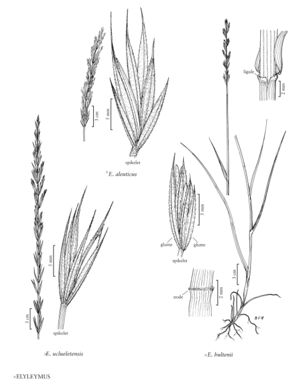Difference between revisions of "×elyleymus aleuticus"
GeoffLevin (talk | contribs) m (Corrected capitalization of "Elyleymus", spelling of "Hulten", and italics in discussion) |
GeoffLevin (talk | contribs) m (Reverted capitalization to allow fixing hierarchy) |
||
| Line 1: | Line 1: | ||
{{Treatment/ID | {{Treatment/ID | ||
| − | |accepted_name= | + | |accepted_name=×elyleymus aleuticus |
|accepted_authority=(Hultén) B.R. Baum | |accepted_authority=(Hultén) B.R. Baum | ||
|publications= | |publications= | ||
| Line 24: | Line 24: | ||
-->{{#Taxon: | -->{{#Taxon: | ||
| − | name= | + | name=×elyleymus aleuticus |
|authority=(Hultén) B.R. Baum | |authority=(Hultén) B.R. Baum | ||
|rank=species | |rank=species | ||
| Line 41: | Line 41: | ||
|subfamily=Poaceae subfam. Pooideae | |subfamily=Poaceae subfam. Pooideae | ||
|tribe=Poaceae tribe Triticeae | |tribe=Poaceae tribe Triticeae | ||
| − | |genus= | + | |genus=×elyleymus |
| − | |species= | + | |species=×elyleymus aleuticus |
}}<!-- | }}<!-- | ||
| − | -->[[Category:Treatment]][[Category: | + | -->[[Category:Treatment]][[Category:×elyleymus]] |
Latest revision as of 16:32, 1 December 2021
Plants rhizomatous. Culms to 75 cm tall, mostly glabrous, hairy for about 1 cm below the spikes, hairs about 0.1 mm. Blades to 15 mm wide, adaxial surfaces with the primary and secondary veins evident, subequal. Inflorescences spikes, to 15 cm long, 20 mm wide, erect, with (1)2 subsessile spikelets per node, pedicels to 1 mm; internodes about 5 mm. Spikelets with 3-5 florets; disarticulation above the glumes, beneath the florets. Glumes 10.5-13 mm long, 1.3-2(2.3) mm wide, linear-lanceolate to linear, flexible, hairy, 3-4(5)-veined, veins prominent, apices unawned or awned, awns to 1.2 mm; lemmas 15-18 mm, lemmas awned, awns 1-7 mm, more or less straight; anthers 2.3-3.9 mm.
Discussion
×Elyleyums aleuticus comprises hybrids between Elymus hirsutus and Leymus mollis. It is known only from the type locality, Atka, Alaska. It probably occurs at other locations where the two parents are sympatric.
Selected References
None.
